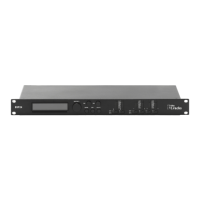15
“Centre frequency”: the selectable frequency range is from
20Hz to 20kHz in steps of 1/24 of an octave and can be adjusted
by rotating the “NAV/PM1” encoder.
“Bandwidth BW”: the selectable BW range is from 0.05 octave to
3 octave in steps of 0.05 octave and can be adjusted by rotating
the “PM2” encoder.
“Gain”: the selectable gain range is from -15dB to +15dB in
steps of 0.5 dB and can be adjusted by rotating the “PM3”
encoder.
Low Shelving Filter: As an example, if you want to set a low
shelving lter within EQ-1 then the PM2 encoder has to be
rotated counter-clockwise until the desired low shelving lter,
say -6LoSh, appears on the screen, the GAIN at say +3.0dB
using the PM3 encoder and the high cut frequency at say
1.00KHz with the NAV/PM1 encoder.
The EQ sub-menu screen will show the following:
Note: Once the desired low shelving lter is selected, the PM3
can then be used to select the desired GAIN and when the
GAIN is set at a value different from 0.0dB, then the lter type
cannot be changed, until this GAIN is returned to 0.0dB.
Once in the low shelving lters edit screen all the lter
parameters can be modied using the “NAV/PM1”, “PM2” and
“PM3” encoders for editing the lter’s high cut frequency, lter
order and gain.
The hi-cut frequency of the low shelving lter can be edited
using the “NAV/PM1” encoder, the lters order can be adjusted
by the “PM2” encoder and the gain the “PM3” encoder:
“Hi Cut Frequency”: the selectable frequency range is from 20Hz
to 20kHz in steps of 1/24 of an octave and can be adjusted by
rotating the “NAV/PM1” encoder.
“Low Shelving Order”: the selectable low shelving lter range can
be selected between the 1
st
(Lo-1
st
.) and the 2
nd
(Lo-2nd.) one.
“Gain”: the selectable range of gain is from -15dB to +15dB
in steps of 0.5 dB and can be adjusted by rotating the “PM3”
encoder.
High shelving lter: As an example if you want to set a high
shelving lter within EQ-1 then the PM2 encoder has to be
rotated counter-clockwise until the desired high shelving lter
say -6HiSh appears on the screen, the GAIN at say +3dB using
the PM3 encoder and the low cut frequency at say 1.00KHz
with the NAV/PM1 encoder.
The EQ sub-menu screen will show the following:
Note: Once the desired high shelving lter is selected, the
PM3 can then be used to select the desired GAIN and when the
GAIN is set at a value different from 0.0dB, then the lter type
cannot be changed until this GAIN is returned to 0.0dB.
Once in the high shelving lter edit screen all the lter
parameters can be modied using the “NAV/PM1”, “PM2” and
“PM3” encoders for editing the lter’s low cut frequency, lter’s
order and gain.
The ‘Lo Cut Frequency’ of the high shelving lter can be edited
using the “NAV/PM1” encoder, the lter order can be adjusted
by the “PM2” encoder and the Gain the “PM3” encoder:
“Lo Cut Frequency”: the selectable frequencies range is from
20Hz to 20kHz in steps of 1/24 of an octave and can be adjusted
by rotating the “NAV/PM1” encoder.

